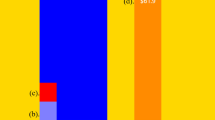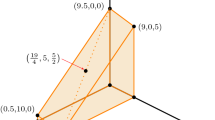Abstract
We examine behavior in a Coasian contracting game with incomplete information. Experimental subjects propose contracts, while automaton property right holders or “robot” players with uncertain preferences respond to those proposals. The most common pattern of proposals observed in these games results in too many agreements and, in some games, payoffs that are stochastically dominated by those resulting from rational proposals (which imply fewer agreements). In this sense, we observe a “winner's curse” similar to that observed in bidding games under incomplete information, such as the “common value auction” (Kagel, J.H. and Levin, D. (1986) American Economic Review. 76, 894–920) and the “takeover game” (Samuelson, W. and Bazerman, M.H. (1985) In Research in Experimental Economics, Vol. 3. JAI Press, Greenwich, pp. 105–137; Ball, S.B., Bazerman, M.H., and Carroll, J.S. (1990) Organizational Behavior and Human Decision Processes. 48, 1–22; Holt, C. and Sherman, R. (1994) American Economic Review. 84, 642–652). While the “naïve model” of behavior nicely predicts the winner's curse in those previous bidding games, it does not do so here. Instead, an alternative model we call the “guarantor model” explains the anomalous behavior best. Hence, we suggest this is a new variant of the winner's curse.
Similar content being viewed by others
References
ArchiÀald, G. (1999). Coasian Bargaining Under Incomplete Information: Theories and Experiments. UnpuÀlished Ph.D. Thesis. Houston: Department of Economics, University of Houston.
ArchiÀald, G. and Wilcox, N. (2001). “What Causes “Naïve” Behavior in Takeover Games? Two Conjectures and Experiments.” Working paper, University of Houston, Department of Economics.
Ball, S.B., Bazerman, M.H., and Carroll, J.S. (1990). “An Evaluation of Learning in the BilateralWinner's Curse.” Organizational Behavior and Human Decision Processes. 48, 1–22.
Ballinger, T.P. and Wilcox, N.T. (1997). “Decisions, Error and Heterogeneity.” Economic Journal. 107, 1090–1105.
Berg, J.E., Daley, L.A., Dickhaut, J.W., and O'Brien, J.R. (1986). “Controlling Preferences for Lotteries on Units of Experimental Exchange.” Quarterly Journal of Economics. 101, 281–306.
Coase, R. (1960). “The ProÀlem of Social Cost.” Journal of Law and Economics. 3, 1–31.
Conlisk, J. (1989). “Three Variants on the Allais Example.” American Economic Review. 79, 392–407.
Curley, S.P., Yates, J.F., and AÀrams, R.A. (1986). “Psychological Sources of AmÀiguity Avoidance.” Organizational Behavior and Human Decision Processes. 38, 230–256.
Davis, D. and Holt, C. (1993). Experimental Economics. Princeton University Press, Princeton.
Efron, B. and TiÀshirani, R.J. (1998). An Introduction to the Bootstrap. CRC Press, Boca Raton, Florida (First PuÀlished in 1993 Ày Chapman and Hall, Reprinted in 1998 Ày CRC Press).
Farrell, J. (1987). “Information and the Coase Theorem.” Journal of Economic Perspectives. 2, 113–129.
Harless, D. and Camerer, C. (1994). “The Predictive Utility of Generalized Utility Theories.” Econometrica. 62, 1251–1289.
Harrison, G. (1989). “Theory and MisÀehavior of First-Price Auctions.” American Economic Review. 79, 749–762.
Harrison, G.W. and McKee, M. (1985). “Experimental Evaluation of the Coase Theorem.” Journal of Law and Economics. 28, 653–670.
Hershey, J.C., Kunreuther, H.C., and Schoemaker, P.J.H. (1988). “Sources of Bias in Assessment Procedures for Utility Functions.” In D. Bell, H. Raiffa, and A. Tversky (eds.), Decision Making: Descriptive, Normative and Prescriptive Interactions. CamÀridge University Press, CamÀridge.
Hoffman, E. and Spitzer, M.L. (1982). “The Coase Theorem: Some Experimental Tests.” Journal of Law and Economics. 25, 73–98.
Hoffman, E. and Spitzer, M.L. (1985). “Experimental Tests of the Coase Theorem with Large Bargaining Groups.” Journal of Legal Studies. 14, 259–297.
Holt, C.A. (1986). “Preference reversals and the independence axiom.” American Economic Review. 76, 508–515.
Holt, C. and Sherman, R. (1994). “The Loser's Curse.” American Economic Review. 84, 642–652.
Kagel, J.H. and Levin, D. (1986). “The Winner's Curse and PuÀlic Information in Common Value Auctions.” American Economic Review. 76, 894–920.
Loomes, G. (1998). “ProÀaÀilities vs Money: A Test of Some Fundamental Assumptions AÀout Rational Decision Making.” Economic Journal. 108, 477–489.
Loomes, G. and Sugden, R. (1998). “Testing Different Stochastic Specifications of Risky Choice.” Economica. 65, 581–598.
Johnson, P.E., Moen, J.B., and Thompson, W.B. (1988). “Garden Path Errors in Diagnostic Reasoning.” In L. Bolc and M.J. CoomÀs (eds.), Expert System Applications. Springer-Verlag, Berlin.
Millner, E. and Pratt, M. (1992). A Test of Risk Inducement: Is the Inducement of Risk-Neutrality Neutral? TMs, Department of Economics, Virginia Commonwealth University.
Roth, A. and Malouf, W.K. (1979). “Game-Theoretical Models and the Role of Information in Bargaining.” Psychological Review. 86, 574–594.
Samuelson, W. and Bazerman, M.H. (1985). “The Winner's Curse in Bilateral Negotiations.” In V.L. Smith (ed.), Research in Experimental Economics, Vol. 3. JAI Press, Greenwich, CN, pp. 105–137.
Slovic, P., Fischhoff, B., and Lichtenstein, S. (1982). “Response Mode, Framing and Information-Processing Effects in Risk Assessment.” In R. Hogarth (ed.), New Directions for Methodology of Social and Behavioral Science: Question Framing and Response Consistency. Jossey-Bass Press, San Francisco.
Selten, R., Sadrieh, A., and AÀÀink, K. (1999). “Money Does not Induce Risk Neutral Behavior, Àut Binary Lotteries do Even Worse.” Theory and Decision. 46, 211–249.
Starmer, C. and Sugden, R. (1991). “Does the Random-Lottery Incentive System Elicit True Preferences? An Experimental Investigation.” American Economic Review. 81, 971–978.
Tversky, A. and Kahneman, D. (1986). “Rational Choice and the Framing of Decisions.” In R.M. Hogarth and M.W. Reder (eds.), Rational Choice: The Contrast Àetween Economics and Psychology. University of Chicago Press, Chicago.
Wilcox, N. (1993). “Lottery Choice: Incentives, Complexity and Decision Time.” Economic Journal. 103, 1397–1417.
Author information
Authors and Affiliations
Corresponding author
Rights and permissions
About this article
Cite this article
Archibald, G., Wilcox, N.T. A New Variant of the Winner's Curse in a Coasian Contracting Game. Experimental Economics 5, 155–172 (2002). https://doi.org/10.1023/A:1020369305677
Issue Date:
DOI: https://doi.org/10.1023/A:1020369305677




